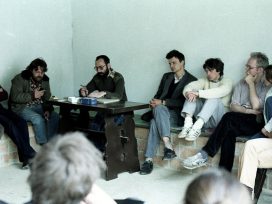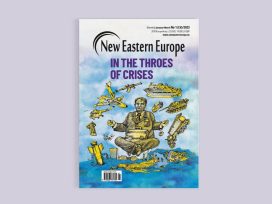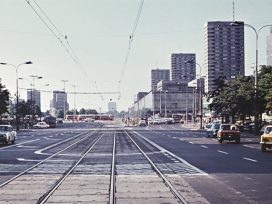In Hungary, a socialist-liberal coalition led by the young and gifted Ferenc Gyurcsány, a billionaire businessman and a former secretary of the Communist Youth League before 1989, was returned to office in 2006 after an election campaign based on left-populist promises which, in a secret speech to his parliamentary party, Gyurcsány himself announced to have been a bunch of deliberate lies. After the speech had been leaked, riots erupted in Budapest, and the headquarters of state television – the symbol of mendacity – was torched. On 23 October 2006, the fiftieth anniversary of the Hungarian revolution of 1956, the police, who had been so signally defeated in the riots a few days before, visited retribution on the protesters, beating up rioters, passers-by, already immobilized prisoners, and whoever else was in their way. (The liberal intelligentsia, to its eternal shame, took the side of police terror.)

G.M. Tamás
Protests continued for months, deteriorating rapidly, dominated by the symbolism of the Arrow-Cross, the Hungarian Nazis famous for their anti-Jewish terror in the encircled Budapest of 1944. The protests were adroitly mined by the parliamentary right, led by the former prime minister, Viktor Orbán. The government coalition proceeded with its radical austerity measures, immense tax increases, and social and health expenditure cuts, closing down hospitals (the first deaths caused by the chaos in the health service have already occurred), schools, and cultural institutions, cutting or stopping subsidies altogether, planning to privatize the hospitals, the railways, the electricity board, and municipal services, liberalizing prices (e.g. those of medications), introducing fees for every visit to a (state) doctor and for university students, doubling the price of public transport, freezing wage and pension increases – all necessary to reduce public debt and trade deficit in order to meet the so-called “convergency criteria” demanded by the European Union, mandatory for joining the eurozone. Credit-rating agencies such as Standard and Poor’s, have more influence on government policy than the electorate.
All this is opposed by deafening anti-communist vociferation, xenophobic, anti-Semitic, anti-Western, and anti-immigrant agitation (there are practically no immigrants in Hungary, but never mind, there may be at some point in the future if the rootless cosmopolitans now in office are not chased away). The polls show that the parliamentary centre-left may disappear; government supporters are openly threatened. There would be a referendum, initiated by the parliamentary right, on the most unpopular measures – certain to be another, unsurprising major defeat for the socialist-liberal government. Because of police abuses, the three major chiefs of the national police, the head of the secret service, and the justice minister responsible had to resign in ignominy. Corruption is rife. Motorway and underground railway construction is in tatters. High-rise office blocks are unfinished or empty. Trust in public institutions is nil.
Thousands of motorcyclists, sporting imitation Wehrmacht helmets and huge Nazi and Arrow-Cross flags on their machines, with the official name of their association – Goy Bikers – proudly emblazoned on their leather jackets, are filling the main streets of central Budapest with their thunderous noise and billowing exhaust fumes. The country is rife with rallies demanding an unelected, non-party upper chamber, and a constitution ascribing sovereignty to the Holy Crown (instead of to the people).
What sense can we make of this outbreak of political lunacy? Unlike the revolutionary upheavals of 1953, 1956, 1968, and 1981 (respectively: East Berlin, Budapest, Prague, Gdansk), the eastern European regime change of 1989 did not proclaim a purer and better socialism, workers’ councils, self-management, or even higher wages for proletarians. It was seen as a re-establishment of “normalcy” and historical continuity and a restoration of the triple shibboleth: parliamentary democracy, “the market”, and an unconditional allegiance to “the west”.
As I have shown elsewhere, this idea of continuity was a mirage. No such system existed in eastern Europe before, but only a backward agricultural society based on ramshackle latifundia, an authoritarian political order led mostly by the military caste drawn from the impoverished gentry, prone to coups d’état, and a public and intellectual life dominated by bitter opponents of a perceived hostile “west”. Elements of modernity, such as they were, were introduced subsequently by Leninist planners and modernizers who, exacting an extremely high price in blood, suffering, scarcity, tyranny, and censorship, were able to impose mobility, urbanization, secularization, industrialization, literacy, numeracy, hygiene, infrastructure, the nuclear family, work discipline and the rest.
These were the foundations on which the new market capitalism and pluralist democracy were built: not a rediscovery of a spurious liberal past, but its introduction by decree for the first time. It was an extremely popular decree for that portion of the population (of which I, too, was an enthusiastic and active member) which participated in the marches, rallies, meetings – not to speak of the shenanigans and skulduggery unavoidable even in utopian politics – and which seemed at the time to have been “the people”, but which was at best 5 per cent of the actual, empirical demos. Still, to us, stepping into the light from our sombre dissident conventicles of a few dozen people, a hundred thousand people appeared as “the masses”. This minority, since dispersed, possessed a political attitude and a worldview that was a combination of 1848 and 1968: a joyful democratic nationalism and constitutional liberalism mingled with a distaste for authority, repression (cultural and sexual), discipline, and puritanism.
These transient ideological phenomena, which seemed so profound, interesting, and solid to us at the time, reflected a state of affairs that nearly all observers had been very slow to understand and even slower to describe comprehensively. Neither the leftish bent of most dissident criticism of “real socialism”, nor the sixty-eightish, libertarian feel of 1989 were ever explained satisfactorily. Even the most glaringly obvious historical comparisons were not made. What I find most curious is that the coincidence in the timing of the crisis of the welfare state – east and west – did not awaken any interest. Historical and political imagination was paralyzed by the unthinking acceptance of the claim that Soviet bloc regimes must have been (in some elusive sense) “socialist” since this is what they have declared themselves to be; and, in a more important sense, this was why they were relentlessly fought by the great western powers of various hues.
Here, a few clarifications should be made. I don’t think there can be any doubt as to “real socialism” having been state capitalism of a peculiar sort. It was a system with commodity production, wage labour, social division of labour, real subsumption of labour to capital, the imperative of accumulation, class rule, exploitation, oppression, enforced conformity, hierarchy and inequality, unpaid housework, and an absolute ban on workers’ protest (all strikes illegal), not to speak of a general interdiction of political expression. The only remaining problem is, of course, the lack of “market coordination” and its replacement by government planning. The term “private property” is misleading here, since if the essence of its significance is the separation of proletarians from the means of production, it also refers to state property, even if we should not try to minimize the considerable differences between the two. If property is control (and legally it is control) then “state property” is private property in this sense: nobody can pretend that in Soviet-type regimes the workers controlled production, distribution, investment, and consumption.
Nor can there be any doubt that post-Stalin state capitalism in the Soviet bloc and in Yugoslavia (roughly 1956-1989) attempted to create a kind of authoritarian welfare state with problems very similar to, and immanent in, any welfare state in the West, be it of the social democratic, Christian Democrat, or Gaullist (or, for that matter, New Deal) variety. (I shall neglect features of welfarist state capitalism in Fascist and Nazi regimes, however apposite.)
The social purpose of any welfare state – including post-Stalinist “real socialism”, with the Gulag closed down – was (we can safely use the past tense here) the attempt to bolster consumption through counter-cyclical demand management, to include and co-opt the rebellious working class through affordable housing, transportation, education, and healthcare, to create a dopolavoro (a Mussolinian idea already much admired by New Dealers, but of course equally prevalent in the Stalinist Russia of the 1930s) replete with paid holidays, mass tourism, cheap popular entertainment, moderately priced sartorial fashions, and The Motor Car. The Merry Kids, a 1930s Soviet musical featuring Young Pioneers (the greatest Russian box-office hit ever), with its unbearable happiness, is undistinguishable from Hollywood or the Third Reich UFA studios’ deliriously smiley output, if perhaps with less stress on sauciness and girls’ legs.
At the same time, in “socialist” eastern Europe there were a few features more reminiscent of Southeast Asian corporate welfare methods – company holiday camps and company-owned holiday hotels, usually free for the employees, managed by the trade unions (access to them was basically a right for all citizens), free crèches and kindergartens for the workforce’s offspring – and some features inherited from European social democracy, but generalized and made mandatory, such as well-stocked lending libraries and cut-price bookshops in every enterprise, affordable good books, theatre and cinema tickets (moreover, books and tickets ordered through your trade union were to be had at half of that already non-competitive price), positive discrimination in favour of working-class youngsters in admission to higher education, job security, cheap basic food, cheap alcohol, cheap tobacco, cheap and plentiful public transport, easy access to amateur and spectator sports. The absence of conspicuous wealth, let alone ostentatious luxury, of the ruling class, together with ever-recurrent shortages and a very reduced consumer choice, sexual puritanism, lengthy terms of military service, the cult of hard work (“popular mechanics” and space flight cults for the young) and a relentless propaganda emphasizing the plebeian and “collectivist” characteristics of the regime where everybody was supposed to know what to do with a tool-chest, a hoe or a pitchfork – all promoted an atmosphere of equality.
An atmosphere, a mood, yes, but also a reality of incomparably greater equality than today. Under “real socialism” nation-states oppressed ethnic minorities – outside Soviet Russia, especially after Stalin’s fall – offering assimilation instead (training films for Hungarian social workers and local council officials in the early 1960s show forcible baths, haircuts, and delousings for nomadic Roma families, operated by police and military hospital personnel, amid scenes of infernal humiliation and artificial for-camera grins), suggesting “unity” and “harmony” and an end to age-old cultural conflicts. The transfer of peasant populations to industrial townships, unlike in the nineteenth century, had been relatively well organized: until the 1970s, when resources had begun to run out, they were moved into high-rise council estates, and immediately offered the whole set of comprehensive and egalitarian social services, including health and culture – there are countries, such as Romania or the former Czechoslovakia, where the majority of the urban population still lives in disintegrating “communist”-era blocks of flats.
There is no doubt that these societies were intolerably authoritarian, oppressive, and repressed, but we are beginning to see how well-integrated, cohesive, pacified, crime-free, and institutionalized they were; a petty-bourgeois dream, but a dream nevertheless. Also, “vertical”: that is, upward social mobility was fast and comprehensive and, since we speak of initially backward, peasant societies, the change (from village to town, from back-breaking physical work in the fields to technological work in the factory, from hunger, filth, and misery to modest cafeteria meals, hot water, and indoor plumbing) was breathtaking. And the cultural change was dramatic. The route from illiteracy and the inability to read a clockface to Brecht and Bartók was astonishingly short. (By the way, it is instructive to see how institutionally embedded cultural needs can be – how half a continent stopped reading serious literature and listening to classical music in a couple of years once the social and ideological circumstances ceased to make such activities both handy and meaningful: Doch die Verhältnisse, sie sind nicht so – “the circumstances are never just so”.)
When, after the regime change of 1989 (in which the present writer played a rather public role, and about which his feelings are retrospectively quite ambivalent), the concomitant onslaught on “state property” through privatization at world market prices, asset-stripping, outsourcing, management buy-outs (companies subsequently bought up by multinationals and closed down to minimize competition and to create new captive consumer markets), caused unheard-of price rises, plummeting real wages and living standards, and massive unemployment. Market liberalization meant that hitherto protected, cushioned, technologically backward local industries could not withstand the intense competition in retail markets which has led to the collapse of local commerce, unable to resist dumping and similar techniques. Almost half of all jobs have been lost. The very real rejoicing over pluralistic political competition and hugely increased freedom of expression was dampened by immiseration and lack of security, accompanied by the ever-increasing dominion of commercial popular culture, advertising, tabloids, and trash. What had been conceived of at first as colourful proved merely gaudy, and as it became more and more shop-soiled, its novel charm has waned.
All this was regarded by the unhappy eastern European populations as unmitigated and incomprehensible catastrophe. The political groups on the ground who possessed a little critical sense had been those which fought the former regime and continued to fight its ghost for a long time to come, and pushed the post-World War II liberal agenda – freedom of expression, constitutionalism, abortion rights, gay rights, anti-racism, anti-clericalism, anti-nationalism – certainly causes worth fighting for but bewildering to the popular classes, who were otherwise engaged – without any attention to the onset of widespread poverty, and social and cultural chaos. These groups combined the “human rights” discourse of the liberal left with the “free to choose” rhetoric of the neoconservative right (they still do, after 18 years) and thought of privatization as the break-up of the almighty state, which – armed with the weapon of redistribution – appeared to be the enemy to beat, saw the “dependency culture” as the ideological adversary, preventing the subjects of the Sozialstaat from becoming freedom-loving, upright, autonomous citizens. I remember – I was a member of the Hungarian parliament from 1990 to 1994 – that we discussed the question of the republican coat of arms (with or without the Holy Crown; the party of “with” won) for five months, but there was no significant debate on unemployment while two million jobs went up into the air in a small country of ten million.
The task of a welfarist rearguard action went to any political force now considered to be beyond the pale. In countries where there was official discrimination against functionaries of the “communist” apparat and where the members of the former ruling party had to stick together for self-protection and healing wounded pride, as in East Germany and the Czech Republic, this was incumbent upon the so-called “post-communist left”; and for the rest, the task was usually taken up by extreme nationalist and “Christian” parties. Since there was a certain continuity of personnel between the ruling “communist” parties’ pro-market, reformist wing (and their expert advisers in universities, research institutes, and state banks) who, being at the right place at the right time, profited handsomely from privatizations, there was a superficial plausibility to the popular theory according to which “nothing has changed”; it was just a conspiracy to prolong the rule of a discredited ruling class. The truth of the matter is, of course, that the changes have been so gigantic that only a fraction of the nomenklatura was able to recycle itself into capitalist wheeler-dealers. The ultimate winner was nobody local, but the multinational corporations, the American-led military alliance, and the EU bureaucracy.
Nevertheless, there is a grain of truth in this popular theory, namely the suspicion that the contrast between planned state capitalism (a.k.a. “real socialism”) and liberal market capitalism may not be as great as was solemnly proclaimed in 1989. Popular theories formulated as paranoid urban legends, however understandable, cannot (and should not) replace analysis. But they do have political significance, especially as many successor parties to former “communist” organizations are now touting the neoconservative gospel (the term “neoliberal” is something of a misnomer: today’s ultracapitalists and market fundamentalists are no liberals by any stretch of the imagination) and are dismantling the last remnants of the welfare state. Hence the strange identification in some countries of eastern Europe of “communists” with “capitalists” – after all, it is frequently former “communists” who are doing this to us, it is always the same people on top, the democratic transformation was a fraud, this is all a Judeo-Bolshevist cabal and so on.
Now the identification of socialism and capitalism is well known to have been a Nazi cliché – both are racially alien – but “the circumstances are never just so”; they could not be more different. After all, communists and social democrats in the 1920s and 1930s were united and adamant in their false consciousness concerning their integral opposition to capitalism and tyranny. False consciousness does not preclude sincerity. The ex-communist parties at the beginning of the twenty-first century are opposed not only to socialism but to the most elementary working-class interests: this is nothing new and it is also not limited to eastern Europe. (When speaking of eastern Europe, I always include the European part of the former Soviet Union, following the good example of General de Gaulle.) After all, the Italian Communist Party and its leader, Enrico Berlinguer, called for austerity measures and insisted on the proletarian duty to acquiesce in them two years before Mrs Thatcher’s accession to power. (The right wing of the former PCI, the DS, is now proposing a merger with its enemy of sixty years, the Christian Democrats…) Therefore the cliché, while it has not become any truer, represents fair and just historical revenge.
This is why and how the neoconservative counter-revolution is countered by forms of resistance couched in the terms of the pre-war nationalist and militarist right, often intermingled with open fascist rhetoric and symbols and, in the case of the former Soviet Union, extreme eclecticism trying to synthesize Stalinism and fascism. (The Communist Party of the Russian Federation, the main opposition force in Russia, is inspired by the loony ideologues of the White Guards who represented the political “brains trust” of the general staff of Admiral Kolchak and Baron Wrangel.) There is a great variety of political solutions. After the defeat of the “neoliberal” or neoconservative regime of ex-communist President Kwasniewski in Poland, the ultra-Catholic Kaczynski twin brothers’ act, however ridiculous it may have appeared at first, is quite successful and is consolidating itself by combining extreme social conservatism, anti-gay, anti-women, anti-minorities, anti-Russian, anti-German, anti-Semitic, and, above all, anti-communist paranoia, with monetarist orthodoxy, pro-Bush military zeal, persecution of everybody on the left (they have stopped the pensions of the few surviving veterans of the International Brigades in the Spanish Civil War in the 1930s), censorship, and savage ethnicist propaganda. Forty-one Polish MPs, members of the majority in the Diet, proposed a bill for the election of Jesus Christ as honorary president of Poland (some would amend this to honorary king). The speaker threw it out on a technicality, they did not dare to put it to a vote: it might have won.
In Slovakia, the government of the left social democrat, Robert Fico, is an alliance of his own party with the nationalists of Vladimír Meciar and the quasi-fascist National Party led by the notorious alcoholic blowhard, Ján Slota. Mr Fico had the effrontery to increase pensions, cut public transport prices, and stop the dismantling of state-managed, essentially free healthcare and public education. It is an immensely popular government, made even more so by its sharp anti-Czech and anti-Hungarian nationalism combined with pro-Russian leanings. Add to this the seeming inability of the Czech Republic, Romania, and Serbia to put together a working parliamentary majority; the anti-Russian madness gripping the Baltic statelets together with very real, apartheid-style discrimination against their ethnic Russian minorities; the persecution and segregation of the Roma minorities everywhere (said the president of Romania of a journalist from whom he personally wrestled and stole, well, confiscated, her mobile phone: “I won’t talk to this stinking Gipsy girl”); the total collapse of ethnic enclaves “statified” by the august “international community” – Bosnia, Kosovo, Montenegro, Macedonia, Moldova/Transnistria, and the Stalinist intermundium of Belarus; the expulsion of ex-Yugoslav residents from Slovenia: and you have a picture of the “new democracies”, the brave soldiers of the “coalition of the willing”, Mr Rumsfeld’s and Mr Cheney’s “new Europe”.
Liberal commentators speak of an insurgency against modernity. This is utter nonsense. The neoconservative (or neoliberal) counter-revolution has attacked the nation and especially the lower middle classes on two fronts.
First, it has ignored the fact that social welfare institutions are the backbone of national identity, the only remaining principle of cohesion in a traditionless capitalism. It is not only the loss of livelihood, but the perceived loss of dignity, the loss of the sense of being looked after, protected, and thus respected by the community represented by the state which is at stake. Upward mobility was the greatest triumph of planned welfare states, internalized as dynamic equality. The loss of class status (this latter characteristically symbolized in eastern central Europe by a university degree: even a starving Herr Doktor is a gentleman), the feeling that the descendants of tradespeople, civil servants, teachers, and physicians may have to do physical work, again, or flee somewhere as illegal migrants, to be déclassé, is an intolerable threat. This insurgency is the revolt of the middle classes against loss of nation and loss of caste.
Second, identifying with the bulwarks and battlements of the welfare state created by the communists is ideologically impossible for the middle classes. It would be a tremendous loss of face, since “communism” symbolizes defeat and the past, and the petty bourgeoisie is nothing if not modernist and driven by the myth of achievement, self-improvement, and the rest. They cannot openly defend the institutions that gave them their dignity in the first place, which have made peasants into bureaucrats and intellectuals, since this would be to acknowledge the shameful agrarian past and the equally shameful “communist” legacy. Thus, by representing the neoconservative (or neoliberal) destruction as the work of communists, shame can be avoided and the defence of pre-1989 institutional arrangements made acceptable. Also, former communist party or communist youth secretaries cannot say that they never belonged to that institutional order and they have nothing to be thankful for its blessings; they have to declare that the dismantling of that order is the correction of a mistake. So they appear fallible and opportunistic, not the harbingers of a new era, liberty, or whatever.
So the new counter-revolutionaries can be fashioned as being of both the left and the right, and the impeccably anti-communist foes of the “communist” privatizers, monetarists, supply-siders, and globalizers. They can defend the Bolshevik-created welfare state without giving an inch to Bolsheviks who went from the International to the Multinational, since both can be opposed by the idea of militant ethnicity, something quite different from classical nationalism, the latter built upon the legal and political equality of all citizens, regardless of creed and race within an independent and sovereign nation-state.
Since this outbreak of political lunacy in eastern Europe is as much a defensive reaction to neoconservative or neoliberal globalization and neo-imperialism as the anti-capitalist version of the new social movements in the west, we need to consider briefly the question of parallels between the two. The former’s struggles are largely symbolic: compare, for example, the protests against the G8 summit meeting at Heiligendamm. Let us suppose for a moment that the protesters were to “win” and manage to chase away the assorted heads of state and other great panjandrums from Mecklenburg-Vorpommern – what would happen? They would return to their respective seats of government, with a few bruises, perhaps – end of story. There are no specific demands (“make capitalism history” is not one); therefore the protesters are not meeting “bourgeois politics” at the level where it is designed and implemented – and the few really specific demands (in fact, requests) voiced by a moderate wing are confined to the framework of bourgeois politics and therefore not revolutionary (for example, those concerning carbon emissions, migrant labour, intellectual property rights, etc.), so ultimately compatible with bourgeois (mainstream liberal) politics even if they have few prospects of immediate success. Violence erupts because the protesters are opposed to the “system” but the system is not invested in this arbitrary congeries of nation-state bosses, who are not exercising their true, that is, legal power in this setting. What is threatened (unlike in the case of communist or socialist revolutions) is not a regime change, but chaos. Chaos cannot be met by repression (although it can be suppressed and “cleaned up” by police and Bundeswehr), since only counter-power can be repressed, and protest as such is not power. Repression itself can be made, on the other hand, into chaos. Power does not encounter counter-power, unlike in the case of classical – especially European – revolutions.
Yet it is also important to recognize that the Zeitgeist of protest among young western Europeans is very different from young eastern Europeans. For however they may imitate the formers’ Palestinian scarves and bandannas, their hoods and masks, their stone-throwing, and the rebel cool they have watched enviously on television, what distinguishes the latter is that they combine all this with extreme authoritarianism, racism, and so on. The young middle-class protesters and the militants of Catholic, ethnicist, xenophobic-populist parties in eastern Europe fear above all loss of status, becoming déclassé, something familiar from the young hard right in central and eastern Europe in the 1920s and 1930s but also from what we know about some of the motivations of student protest in the 1960s. With their demand for order, hierarchy, national unity, a definite end to everything they consider deviant behaviour – alarmingly reminiscent of fatwas issued by al-Azhar and the Vatican – they, however opposed in principle to haute finance and rootlessly cosmopolitan globalization, unwittingly serve the present order which has nothing to fear from ethnic hatred, militarism, homophobia, and a nostalgia for stiffly established order. Whatever their mistakes, the new social movements in the west and in the south are not guilty of anything like that.
Meanwhile, even more than in the west, the working class is silent. There are hardly any strikes. This battle is fought between transnational capital and its native agents, and the local, ethnic middle classes and the ethnicist and clericalist intelligentsia. An authentic left has not surfaced.
Yet.
 This essay is published in “Global Flashpoints, Socialist Register 2008”, www.socialistregister.com, published by Merlin Press, www.merlinpress.co.uk in October 2007.
This essay is published in “Global Flashpoints, Socialist Register 2008”, www.socialistregister.com, published by Merlin Press, www.merlinpress.co.uk in October 2007.








